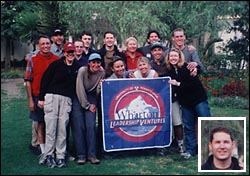Around 4 a.m. I started showing symptoms of altitude sickness. I was exhausted, my head ached and I was very dehydrated. Lori and Adrian helped push me on and I managed to make it until I was in view of the summit, just 700 feet away. I had wanted to get to a point where, if I couldn’t reach the top, at least I wouldn’t force the whole team to turn around. * * * * * * Teamwork came into play more than leadership. Like the time that Melissa and Rebecca shone their lights back on us so John and I could find the path. And the fact that on the steepest parts of the climbs, we were all roped together and taught how to save ourselves and the group if one person – or all of us – fell. We lived and died as a team. There were no outsiders. We all felt inclusive. We all knew we depended on each other.
Jamie Hammond, a marketing director for Knowledge at Wharton, joined 13 others on a week-long trip to Ecuador as part of Wharton Leadership Ventures, a program designed to help participants develop leadership skills while climbing some of the highest and most beautiful mountains in the world. The trip, organized by Michael Useem, director of Wharton’s Center for Leadership and Change Management, included two professional hikers and nine Wharton MBA students, among them Jamie’s wife Teresa.
Below are excerpts of a journal that Hammond kept during the trip. Interspersed with the journal entries are comments from Useem, one of the creators of the Leadership Ventures program and organizer of an annual trek to Mt. Everest.
Day 1, March 9
We left Philadelphia around 1 p.m. and made it to our rooms in Quito, the capital of Ecuador, by 12 a.m. with no major delays.
Our group – which will attempt to summit Mt. Cotopaxi (19,344 ft.), the highest continuously active volcano in the world – is being led by Adrian Ballinger, director of the mountaineering program at Earth Treks, a professional guide service located in Columbia, Md. The company specializes in rock and ice climbing instruction and mountaineering expeditions. The group also includes Lori, another guide who is a surgeon in Vail, Colo., and was a guide on the last Wharton expedition to Ecuador, and Useem, the trip’s academic leader.
The MBA students include Dave, our logistical organizer and the only fluent speaker of Spanish; Huybert, an avid endurance athlete from the Netherlands; Rebecca, an experienced climber who spent last summer trekking in Nepal; Jeff, a radiologist and the trip’s physician; Melissa, an enthusiastic runner; Kevin, one of the quickest climbers of the group (with the best sunscreen); Laura, a Canadian who works for the Wharton admissions office and has traveled extensively through South America; John, Laura’s fiance and an experienced South American traveler who has hiked the Machu Picchu trail with Laura; and Teresa, who has light climbing and hiking skills and who provided not only me but also everyone else in our group with consistent encouragement. Also on the trip was Christina, Jeff’s friend from Boston and a radiologist.
None of us, except Adrian and Lori, have been to the altitude of Cotopaxi. Looking forward to the rest of the week!
Mike Useem: Wharton Leadership Ventures are designed to take participants into settings where they can further their management capacities by confronting real challenges and making tough decisions.They are intended to provide hands-on experiences for exploring and mastering the capabilities of individual and team leadership in business and beyond. Climbing a mountain like Ecuador’s Cotopaxi is sure to bring out such issues as strategic thinking, risk management, and group judgment, and our team arrived in Ecuador ready to face and learn from the anticipated tests of both our mountaineering and management skills.
Day 2, March 10
Today started early. We were up at 7 a.m. and off to breakfast at the Magic Bean, a restaurant owned by an American from New Orleans. Breakfast served as a good Q&A session with Adrian and Lori. Given their knowledge and experience of mountain climbing, they were able to calm many of our fears and answer a lot of our basic clothing and hiking questions.
We headed back to the hotel for our bus tour of Quito, a city of 2.5 million people all located in a valley surrounded by mountains. Our first destination was El Panecillo where there is a very large statue of the Virgin Mary (the Virgin of Quito) standing over the city high on a hill. The view was breathtaking. From this vantage point we also could see the summit of Cotopaxi. It looked enormous.
We then proceeded to the Old Town of Quito, known for its many beautiful churches and old architecture. After a quick lunch we gathered for our first team meeting to discuss our goals (just about everyone’s goal is to reach the summit), our expectations and also our individual strengths and weaknesses. One of my strengths, I said, was that I am a team player and always keep the goals and welfare of the group in mind. On the other hand I can be too stubborn and don’t always quit when I should.
It was a good session in which we learned more about each other and about how our leadership styles will affect our experience. We also discussed the role of teamwork in decision making.
We then went to Adrian’s room for a quick lesson on harnesses and some tips on the gear we should pack tomorrow for our climb up Mt. Pinchincha (15,700 ft.), a volcano above Quito. If we choose to climb the ridge at Pinchincha, we will use some of the rock climbing techniques that we just practiced. If we choose not to do the ridge we can take a path that goes around it but still takes us to the top.
After dinner we packed for Pinchincha, did some reading and went to bed. We will wake up in six short hours. If/when we get to the top, we will be higher than any other peak in the continental United States. And that’s just the warm-up.
Mike Useem: Our team of 12 arrived in Quito already well prepared for the challenges we are likely to face. Prior to leaving the U.S., three of its members – Rebecca, Dave, and Huybert – organized a number of day hikes, mountain-bike rides, rock-gym visits, and planning dinners. We know that we will need to depend upon one another during our ascent tomorrow of Pinchincha and later of Cotopaxi, and we are reminded that it is vital to build a team before the teamwork will be called upon. Like well-formed teams in product manufacturing, management consulting, and investment banking, we have pre-established a collective foundation for facing the problems we are sure to confront on the mountains ahead.
Day 3, March 11
Today we awoke at 6 a.m., had a quick breakfast and were on the road heading to Pinchincha by 7:30 a.m. The route took us through depressed villages in the hills and over some very bumpy roads. We finally arrived, packed our gear and set off around 9:30 a.m.
The summit was covered by clouds but the path was lit beautifully by the sun. We started in a grassy area trekking through some moderate hills. Everyone chatted during the hike, although each of us was a little short of breath due to the altitude. The grassy area then turned to a steep grassy ridge which led us to the big rock ridge. Here we took a break and considered the two routes available to us: One was the route for which we had practiced our technical roping skills. The other was a path to the right of the ridge with some hilly trails and light rock scrambling areas.
Several factors helped us reach a decision. 1. The weather was getting worse with some approaching clouds. 2. There was no turning back once you were on the ridge. 3. People were tired. 4. We might not make it back before dark. 5. The main goal of the trip was to get to a high altitude and acclimatize.On the other hand: 1. The ridge would be a lot more challenging (never challenge a Wharton MBA student). 2. We wanted to use our newly required rope skills. 3. There would be a greater sense of satisfaction.
After consulting our guides and debating the two options, the group decided on the path. It turned out to be the right choice. The clouds did move in and the temperature dropped significantly. We all ended up reaching the summit and our goal of acclimatizing.
I was fine on the way up but felt sick once we reached the top. Lori informed me that it was probably altitude sickness. We got down to the car by 5 p.m. and reached the restaurant by 7 p.m. There, we discussed the decisions that were made. The consensus was that we had made the right choice. We could have climbed along the rock ledge but it would have been strenuous and cold and would not have left us with much energy to get back.
Tomorrow we work on climbing skills at an outdoor wall. Then we get ready for traveling to the hut that will be our refuge before we attempt Cotopaxi.
Mike Useem: The process of reaching a team decision on whether to attain the summit via the technical ridge or the hilly path proved instructive. Some team members expressed strong preference for the ridge, while others vigorously urged the path. Whatever the decision, we would all be bound by it since the group would have to stay united to reach the summit. During our venture, we rotate team leadership every day among the participants, and today’s leader – Huybert – displayed the best in team decision-making: He reminded us of our objectives (for all of us to scale the summit and return safely); he drew out critical facts from our two professional guides (e.g., the ridge requires extensive use of ropes and there is no easy way off the ridge once we are on it); he encouraged everybody to express their personal preferences (most of us did); he suppressed his own preferences (he wanted the ridge) since he was serving as the day’s leader; and he brought the decision to a timely resolution that reflected the best interests of the entire group. It was a confirming lesson in the importance of good leadership if a team is optimally to achieve its goals.
Days 4 and 5, March 12 and 13
On Tuesday we slept in and then headed to the “rock wall.” We practiced saving ourselves if we were to fall into a crevasse and we also practiced saving others who couldn’t help themselves. All of us realized that once we were put into our rope teams, those systems we learned would save us if something bad were to happen.
We then had our group meeting for the day. One of the discussion points: How would we feel if we didn’t make it to the top?
The consensus: After Pinchincha, people wouldn’t be as upset if they didn’t reach the top of Cotopaxi as they said they would have been earlier in the week. Instead of summiting, the goals seem to have shifted to having an adventure, making sure everyone was having a good time, ensuring the safety of the group and making and keeping friends.
We then fitted our crampons and boots and talked about what needed to be packed for the next day.
Mike Useem: In mastering the technical skills of mountaineering, we reconfirm the adage that expertise is too important to be left to the experts. We and our guides work to ensure that every team member knows not only how to pull themselves up a rope out of a glacial crevasse, but also how to rescue an injured team member from a fall into a crevasse. The guides are of course steeped in the art of crevasse rescue, but we all want to master the methods so that we can take care of ourselves should our guides be unable to lend assistance. In both mountain climbing and company management, we remind ourselves that the team is only as strong as its weakest link.
Wednesday was my day to lead, along with Laura. Each day two people were assigned this leadership role, which included making sure everyone was accounted for and facilitating discussions. I woke up early to get my gear in order, have breakfast, and help others prepare for the trek ahead. Each of us carried between 45 and 60 pounds of equipment and food.
Everyone made it up to the hut – a 90 minute hike – feeling good; we hung our stuff to dry and then had our meeting, which focused on the types of mental state necessary for a big climb.
The group is gelling and everyone is starting to get excited. Tomorrow we practice on the glacier and decide on rope teams.
Mike Useem: Shared mindset and mental discipline are critical to any collaborative undertaking, and we increasingly focus on what it will take for each of us – and for all of us – to reach the summit of this great volcanic peak whose ice-covered summit now looms far above us. We begin to encourage one another to be ready to climb as high as possible – but also to be savvy about recognizing when one’s reserves are too taxed to safely go higher. We seek to be aware of each of our team member’s medical condition, physical stamina, and mental attitude since we anticipate that they will critically affect the likelihood that each and all of us can safely ascend and descend Cotopaxi two days from now.
Day 6, 7, 8 March 14, 15 and 16
After going to bed early, we woke up and headed to the glacier to practice our ice climbing skills. We worked on hiking in crampons and with our ice axes and practiced the emergency stop procedure called “self-arresting.” Then we worked on walking on rope teams and jumping over crevasses.
We got back to the hut around noon and had lunch. We then assigned rope teams. The rope team meeting was the most important one of the whole trip because it determined who your partners would be hiking up the mountain. These are the people you would depend on most. Once teams were decided we had meetings and were assigned our guides.
We ate a quick dinner and went to bed at 7 p.m. in anticipation for our 11 p.m. wake up call. Everyone was a little nervous and excited.
We woke up four hours later, got our gear on and were out the door at midnight. The sky was very clear and at 15,744 feet you felt you could almost touch the stars. To the right and below us there was lightning. Adrian was worried that it might move closer but it didn’t.
We headed up the mountain in our teams of five. In my team we had Lori leading, then Melissa, John, Rebecca and I, all separated by 30 ft. of rope each.
There were a few complications on the way up; My headlamp and John’s went out twice. That made it a little difficult to hike, but Rebecca and Melissa helped by shining their lights back periodically so we could find the path.
Around 4 a.m. I started showing symptoms of altitude sickness. I had a headache and was fatigued and very dehydrated, even though I was drinking as much water as I could. Lori and Adrian helped push me on and I managed to make it until I was in view of the summit. I wanted to get to a point where I wouldn’t force the team to turn around. We had a quick meeting between Adrian’s team and Lori’s team at an ice cave right before the headwall.
Adrian radioed to the first group, who had already summited and they informed him they were on their way down. Adrian told them to pick me up on the descent. He let me know they would be down in about an hour. Above all, he repeated several times, don’t let yourself fall asleep.
Adrian then told the rest of the group that they were about to go through the worst hour of their lives. Ahead was the headwall – a climb that was almost straight up to the top of the mountain. Adrian asked if anyone wanted to stay, but everyone accepted the challenge and they all made it to the summit.
Reflecting on my decision, I wondered if I could have made the final 700 feet to the top of the mountain. I thought back to a previous meeting we had with the group and recalled Adrian and Lori stating that they always kept enough in reserve to make it back down.
I did a quick run-through of where I stood physically and it didn’t look good. I was still severely dehydrated, had a headache (which didn’t go away after taking four ibuprofen tablets), was exhausted and hadn’t eaten in the past 12 hours. When I did try to eat something I felt very nauseous and could barely keep it down. I knew that I would be putting the team in danger if I were to push on. I wouldn’t have enough left in reserve to get myself back down the mountain.
I was very disappointed about not being able to join the team at the top but later discussions with the group and with Adrian and Lori revealed that my decision was right. If I had pushed on, I could have put the team in jeopardy.
I made a quick descent with the team that was coming down. My condition improved a little but not much. I had also developed a slight fever by the time I reached the hut. I rested until the rest of the team made it down, about three hours later.
Everyone said that the descent was worse than the ascent. The sun had been out for a long time already and it was melting the snow on the glacier. Many of the climbers had fallen, sometimes even a whole team at once, but the self-arresting skills we learned kept them from going too far. The heat and the sun bouncing off the glacier tired the teams and caused severe sunburn. At one point Adrian’s watch read 118 degrees. Everyone returned sunburned, tired and dehydrated.
We managed to make it down from the hut to the bus and then back to the hotel. It had been the most successful Wharton trip to Cotopaxi so far in terms of the number of people who had reached the summit.
The next day we headed to Otovalo, the Indian market famed for its woven textiles. We also had our last team meeting. We asked ourselves what did each person take away from the trip?
For me, it was a sense that anything is attainable. I had never in my life thought that I would go that high on a mountain. During the trip Adrian had talked a lot about perceived limits and how they can stop you from trying to do things that once seemed unattainable. We all had pushed through these perceived limits, including me. I also learned how important it is to communicate all the time with everyone on the team. Adrian and Lori always kept the door open to us all for questions. At the same time it was clear that they were the leaders. They had the experience and they were in charge. They were also motivators. They kept me going when I had altitude sickness, telling me to put one foot in front of the other, until I finally said no. That’s when I stopped and leaned up against an ice cave, looking up at the summit of Cotopaxi, 700 feet away. It was a beautiful sight, and I know that I will never forget it.
Mike Useem: Jamie’s clear-headed decision to stop 700 feet below the summit reconfirmed the importance of individual decisions for collective success. Though the nearby summit was alluring and “summit fever” might have tempted others to push up, Jamie insisted on making a tough appraisal of both his own condition and its impact on the likelihood that others might reach the summit. Had he continued to climb, he may have exceeded his own reserves and that in turn could have forced his rope team to descend before attaining the top. He decided on his own what to do, and he did the right thing. As in business, when the pressure is on and the stress is acute, staying clear-minded and remaining riveted on the team’s goals is essential for both personal and organizational achievement. And it is through such experiences as these that we all can learn to be more mindful of the leadership that is required in an era that can be as challenging and unpredictable as the upper reaches of a great mountain.



